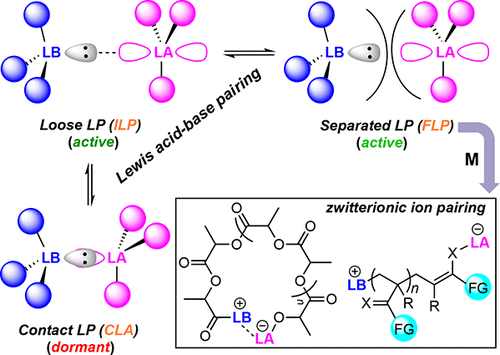当前位置:
X-MOL 学术
›
Chem. Rev.
›
论文详情
Our official English website, www.x-mol.net, welcomes your feedback! (Note: you will need to create a separate account there.)
Polymerization of Polar Monomers Mediated by Main-Group Lewis Acid–Base Pairs
Chemical Reviews ( IF 62.1 ) Pub Date : 2018-10-11 00:00:00 , DOI: 10.1021/acs.chemrev.8b00352 Miao Hong 1 , Jiawei Chen 2 , Eugene Y.-X. Chen 3
Chemical Reviews ( IF 62.1 ) Pub Date : 2018-10-11 00:00:00 , DOI: 10.1021/acs.chemrev.8b00352 Miao Hong 1 , Jiawei Chen 2 , Eugene Y.-X. Chen 3
Affiliation

|
The development of new or more sustainable, active, efficient, controlled, and selective polymerization reactions or processes continues to be crucial for the synthesis of important polymers or materials with specific structures or functions. In this context, the newly emerged polymerization technique enabled by main-group Lewis pairs (LPs), termed as Lewis pair polymerization (LPP), exploits the synergy and cooperativity between the Lewis acid (LA) and Lewis base (LB) sites of LPs, which can be employed as frustrated Lewis pairs (FLPs), interacting LPs (ILPs), or classical Lewis adducts (CLAs), to effect cooperative monomer activation as well as chain initiation, propagation, termination, and transfer events. Through balancing the Lewis acidity, Lewis basicity, and steric effects of LPs, LPP has shown several unique advantages or intriguing opportunities compared to other polymerization techniques and demonstrated its broad polar monomer scope, high activity, control or livingness, and complete chemo- or regioselectivity, as well as its unique application in materials chemistry. These advances made in LPP are comprehensively reviewed, with the scope of monomers focusing on heteroatom-containing polar monomers, while the polymerizations mediated by main-group LAs and LBs separately that are most relevant to the LPP are also highlighted or updated. Examples of applying the principles of the LPP and LP chemistry as a new platform for advancing materials chemistry are highlighted, and currently unmet challenges in the field of the LPP, and thus the suggested corresponding future research directions, are also presented.
中文翻译:

由主基路易斯酸-碱对介导的极性单体的聚合
新的或更可持续的,活跃的,有效的,受控的和选择性的聚合反应或方法的开发对于合成具有特定结构或功能的重要聚合物或材料仍然至关重要。在这种情况下,主要的路易斯对(LPs)引发的新聚合技术被称为路易斯对聚合(LPP),它利用了路易斯的路易斯酸(LA)和路易斯碱(LB)位点之间的协同作用和协同作用可以用作沮丧的路易斯对(FLP),相互作用的LP(ILP)或经典路易斯加合物(CLA),以实现协同单体活化以及链引发,扩散,终止和转移事件。通过平衡路易斯的酸度,路易斯的碱性和LP的空间效应,与其他聚合技术相比,LPP显示出数项独特的优势或引人入胜的机会,并证明了其广泛的极性单体范围,高活性,可控性或活性,以及完全的化学或区域选择性,以及其在材料化学中的独特应用。对LPP的这些进展进行了全面的综述,其中单体的范围集中在含杂原子的极性单体上,而与LPP最相关的主要基团LA和LB分别介导的聚合也得到了强调或更新。重点介绍了将LPP和LP化学原理应用作为推进材料化学的新平台的实例,并提出了LPP领域当前未解决的挑战,并提出了相应的未来研究方向。
更新日期:2018-10-11
中文翻译:

由主基路易斯酸-碱对介导的极性单体的聚合
新的或更可持续的,活跃的,有效的,受控的和选择性的聚合反应或方法的开发对于合成具有特定结构或功能的重要聚合物或材料仍然至关重要。在这种情况下,主要的路易斯对(LPs)引发的新聚合技术被称为路易斯对聚合(LPP),它利用了路易斯的路易斯酸(LA)和路易斯碱(LB)位点之间的协同作用和协同作用可以用作沮丧的路易斯对(FLP),相互作用的LP(ILP)或经典路易斯加合物(CLA),以实现协同单体活化以及链引发,扩散,终止和转移事件。通过平衡路易斯的酸度,路易斯的碱性和LP的空间效应,与其他聚合技术相比,LPP显示出数项独特的优势或引人入胜的机会,并证明了其广泛的极性单体范围,高活性,可控性或活性,以及完全的化学或区域选择性,以及其在材料化学中的独特应用。对LPP的这些进展进行了全面的综述,其中单体的范围集中在含杂原子的极性单体上,而与LPP最相关的主要基团LA和LB分别介导的聚合也得到了强调或更新。重点介绍了将LPP和LP化学原理应用作为推进材料化学的新平台的实例,并提出了LPP领域当前未解决的挑战,并提出了相应的未来研究方向。



























 京公网安备 11010802027423号
京公网安备 11010802027423号